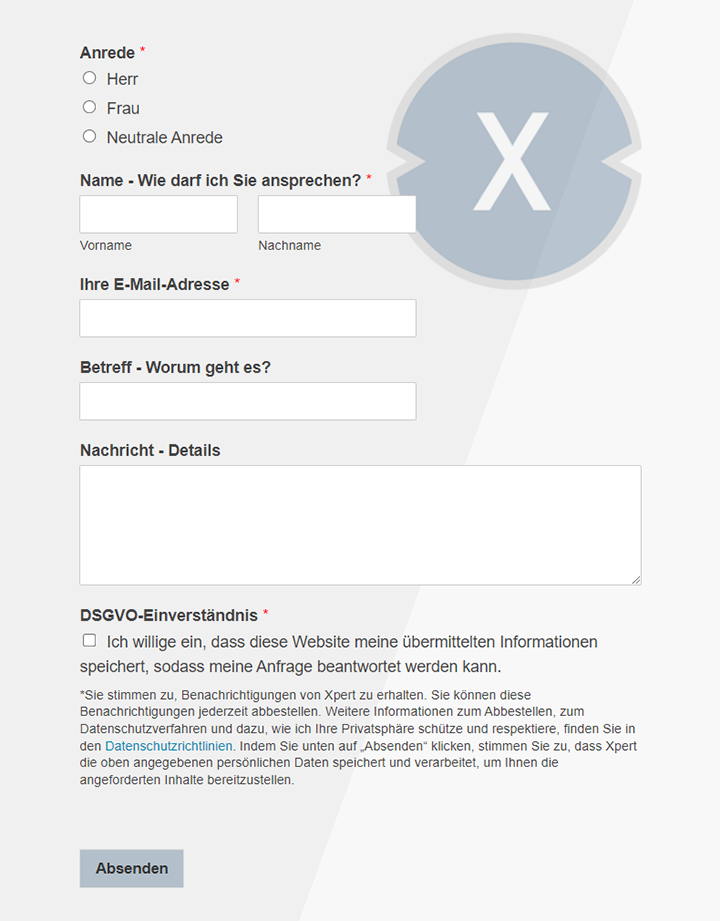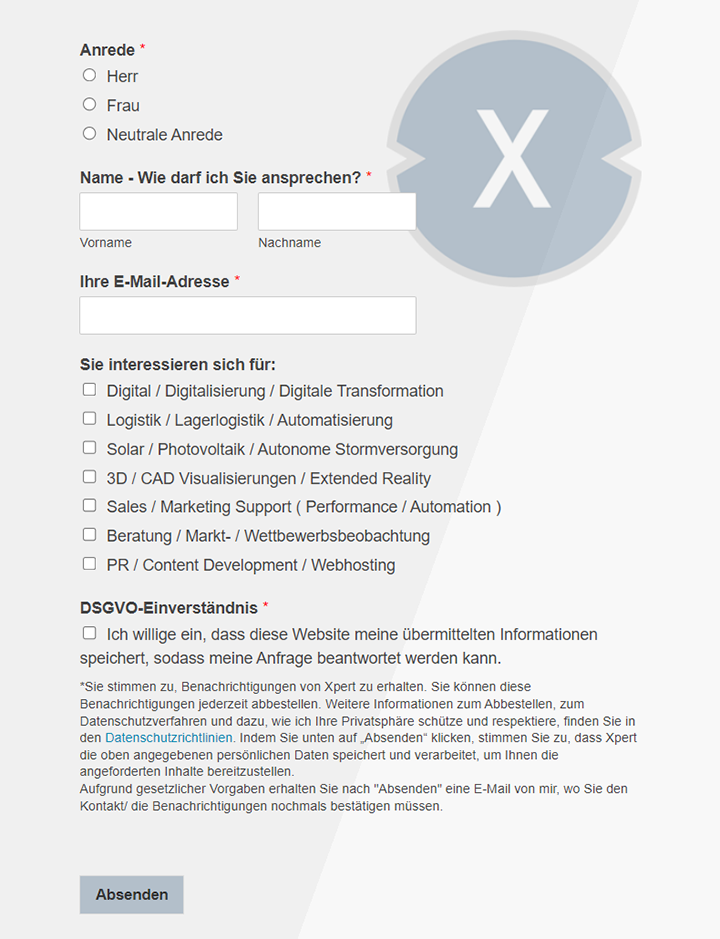The HACCP concept: 7 steps to absolutely safe food – Comprehensive questions and answers on food safety
Xpert pre-release
Language selection 📢
Published on: September 21, 2025 / Updated on: September 21, 2025 – Author: Konrad Wolfenstein

The HACCP concept: 7 steps to absolutely safe food – Comprehensive questions and answers on food safety – Image: Xpert.Digital
From NASA to your kitchen: The surprising history of the HACCP concept
### HACCP Mandatory for Restaurants & Co.: Are You Really on the Safe Side? ### Critical Control Points: Do You Recognize the True Risks in Your Business? ### More Than Just a Regulation: How to Save Costs and Avoid Scandals with HACCP ###
What is the HACCP concept?
The HACCP concept stands for Hazard Analysis and Critical Control Points. It is a systematic, preventative system for ensuring food safety that aims to identify, assess, and control potential hazards at all stages of food production, processing, and distribution.
The HACCP system is based on scientific principles and risk analysis and primarily serves to protect consumers from harmful food-related health risks. Unlike conventional inspection methods, which focus on testing final products, HACCP shifts the focus to proactive prevention through systematic control of all production steps.
How did the HACCP concept develop historically?
The origins of the HACCP concept date back to the era of space exploration. In 1959, NASA commissioned the American corporation The Pillsbury Company to develop 100% safe space food for astronauts. The error prevention concepts of the time originated from mechanical engineering and were unsuitable for food production.
Pillsbury applied the FMEA methodology, developed by the US military in 1949 for technical applications, to the food industry and, together with NASA, developed a preventative concept that was made transparent and traceable through highly detailed documentation. Initially, identifying hazards and assessing their risks posed difficulties due to a lack of experience.
The program only received its current name, HACCP, in 1971. In the 1970s and 1980s, various national and international organizations, including the World Health Organization (WHO), became aware of the new HACCP concept. The concept was continually developed – initially three principles became six, and later seven.
The WHO Codex Alimentarius Commission adopted the seven principles and has recommended the application of the HACCP concept since 1993. Many countries and international communities have now enshrined the HACCP concept in law, in the European Union through Regulation (EC) No. 852/2004 on the hygiene of foodstuffs, which has been binding for all member states since January 1, 2006.
What are the seven HACCP principles?
The HACCP concept is based on seven chronologically applicable principles established by the Codex Alimentarius Commission in the late 1980s:
The first principle involves hazard analysis. This involves identifying all potential hazards that may arise at all stages of production, from raw materials to the finished product. Hazard analysis is performed in two steps: first, all potential hazards are identified, then they are evaluated to assess the risk they pose to food safety.
The second principle involves identifying critical control points (CCPs). These are process steps that can help prevent, eliminate, or reduce food hazards. Identifying CCPs requires detailed knowledge of all process steps and the involvement of all departments that come into contact with food.
The third principle involves setting limits for critical control points. These limits are either specified by law or must reflect the state of the art. These limits are used to distinguish between acceptable and unacceptable values in order to avoid, eliminate, or reduce identified hazards.
The fourth principle involves establishing and implementing procedures for monitoring critical control points. The operator must establish appropriate monitoring procedures to ensure continuous monitoring of compliance with the limit values.
The fifth principle involves the definition of corrective measures. If monitoring shows that the limit values cannot be met, appropriate corrective measures must be defined in advance and implemented immediately.
The sixth principle involves the development of verification measures. To verify that steps one to five are implemented in accordance with HACCP, the company must develop appropriate verification measures.
The seventh principle concerns the creation of documentation and records. With this documentation and corresponding records, the food business operator demonstrates that it has implemented all the principles of the HACCP concept in compliance with the law.
What types of hazards are considered in the HACCP analysis?
The HACCP hazard analysis considers all types of hazards that could cause a health hazard. These can be biological, chemical, physical, or even allergic in nature and are the fundamental elements that must be considered in any HACCP system.
Biological hazards arise from pathogenic microorganisms or other organisms that can harm health. These include parasites that can cause direct infection or indirectly through the production of toxins. Examples of biological hazards include foodborne viruses, zoonoses such as Salmonella and Campylobacter, and other pathogenic bacteria. Control of biological hazards is primarily achieved through temperature control during preparation, refrigeration, and storage, as well as through appropriate hygiene measures.
Chemical hazards can be caused by various substances, including cleaning or disinfectant agents, pesticides, toxic metals, certain additives such as nitrites and nitrates, and residues of veterinary drugs. Other examples include mycotoxins, dioxins, antibiotics, and hormones. Chemical hazards can be controlled by monitoring the cleaning and disinfection process, maintaining premises and equipment, controlling raw materials, training staff, and properly storing food separately from chemical substances.
Physical hazards refer to the presence of foreign bodies in food, such as glass, metal, stones, wood, plastic, or insects. Physical hazard control includes the inspection of raw materials by suppliers, as well as controls upon receipt and during production, the provision and maintenance of premises and equipment, and the training of personnel.
Allergic hazards arise from allergens, which require strict control to prevent contamination of allergen-free foods. Strict monitoring of allergen control ensures that all affected individuals receive allergen-free food.
How is a HACCP system implemented in practice?
Implementing a HACCP system requires a systematic approach that begins with five preparatory steps before the actual seven HACCP principles can be applied.
The first preparatory step is to assemble a dedicated HACCP team. This multidisciplinary team should consist of experts from various operational areas, such as quality management, quality assurance, production, technology, warehousing, product development, purchasing, and project management. The team can either be composed entirely of in-house employees or supplemented by external food safety experts.
The second step involves describing the products and processes. The HACCP team creates detailed descriptions of all food products produced in the facility, as well as the processes in place. These descriptions should include information on intended use, packaging, labeling, and shelf life and temperature considerations.
The third step is to create a complete list of ingredients and raw materials. Listing and categorizing all ingredients, raw materials, additives, and packaging or casings helps companies identify risk areas.
The fourth preparatory step involves developing a process flow diagram. Starting with the receipt of raw materials, through the completion of the products, and ending with the dispatch of the goods, each individual processing step is depicted in a diagram. This diagram serves as an accurate representation of the manufacturing process and should be verified using a sample procedure in the plant.
The fifth step ensures compliance with hygiene requirements. Compliance with legal hygiene regulations provides a solid foundation and is a prerequisite for the creation of a HACCP plan. This includes all food hygiene measures such as buildings and facilities, suitable staff, training, facility hygiene, raw material management, cleaning and disinfection, and pest control.
After completing the preparatory phase, the HACCP team can begin developing the plan and systematically applying the seven HACCP principles.
What are the legal requirements for HACCP?
The legal basis for HACCP in the European Union is Regulation (EC) No. 852/2004 on the hygiene of foodstuffs, which has been binding for all member states since January 1, 2006. This regulation is part of the EU's so-called hygiene package and requires all food business operators to apply HACCP principles.
Article 5 of the regulation requires food business operators to establish, implement, maintain, and continuously update a HACCP self-monitoring system. Generally, all food businesses, such as bakeries, butchers, ice cream parlors, and many others, are required to have a HACCP system.
The primary responsibility for the safety of food lies with the food business operator. Food safety must be ensured at all stages of the food chain, and for foods that cannot be safely stored at room temperature, especially frozen foods, the cold chain must not be interrupted.
Every food business operator must be able to demonstrate its operational HACCP concept through documents and records. They must ensure that these documents are always up to date. They must demonstrate to the competent authority that they meet these requirements. The HACCP concept must be plausibly documented in writing.
In addition, the EU Food Hygiene Regulation stipulates that perishable foods such as meat, fish, eggs, vegetables, fruit, ice cream, and bread may only be produced, handled, or placed on the market by persons who have undergone training in the relevant specialist knowledge for their respective activities. Proof of this knowledge must be provided upon request to the competent authority.
What are the benefits of implementing a HACCP system?
Implementing a HACCP system offers companies a variety of benefits that go far beyond mere compliance with legal requirements.
The primary benefit is protecting consumers from health risks that can be caused by food. At the same time, a HACCP system protects employees from health risks and contributes to job security.
From an economic perspective, HACCP offers significant advantages. The system enables the effective use of resources to produce safe food, contributes to improving food quality, and avoids product recalls. The focus on preventive measures avoids unnecessary costs. Companies with a HACCP system have better control over their product inventory and can reduce product recalls and liability risks, which can protect against significant financial losses.
HACCP helps build trust with direct customers, such as retailers and processing companies. Meeting customer food safety requirements strengthens business relationships and consumer trust. An effective and well-documented HACCP system ensures orderly operational processes and promotes food safety as well as profitability.
The system contributes to building a trusting relationship with food safety authorities and provides protection against high-profile scandals. In product liability cases, the HACCP system serves as proof of due diligence.
HACCP certification demonstrates to customers and business partners that a company adheres to hygiene safety measures in beverage or food production, thus ensuring its future-proof operation. Certificates such as the International Featured Standard (IFS) Food or the BRCGS Global Standard for Food Safety provide evidence of compliance with due diligence.
Which critical control points are particularly important?
The identification and control of critical control points (CCPs) is a central component of the HACCP system. The most important CCPs vary depending on the type of food production, but some areas are particularly critical to food safety.
Preparation temperatures represent one of the most critical control points. To ensure that food is free of pathogens from the raw materials, the preparation temperature must be properly controlled. A preparation temperature of 100 degrees Celsius kills all microorganisms.
Cooling times and cold storage temperatures are further critical considerations. Bacteria can multiply during food cooling, so appropriate control of cooling times and temperatures is necessary to minimize bacterial growth. Cold foods must be stored at the correct temperature to prevent the growth of microorganisms.
Hot storage temperatures are also of great importance. When storing ready-to-eat foods at high temperatures, it is important to ensure that the temperature is high enough to prevent bacteria from multiplying. The optimal temperature for storing hot foods is at least 65 degrees Celsius.
Allergen control is another important CCP. Foods containing allergens must be controlled in such a way that contamination of allergen-free foods is excluded.
Receiving is often a critical control point, where all incoming goods must be checked for various contaminants before processing. Packaging and onward transportation can also be designated as CCPs to capture any contaminants that may have entered the product during processing.
The more processing steps performed in a particular food processing facility, the more CCPs are generally required to adequately control contamination hazards.
🎯🎯🎯 Benefit from Xpert.Digital's extensive, fivefold expertise in a comprehensive service package | R&D, XR, PR & SEM

AI & XR 3D Rendering Machine: Fivefold expertise from Xpert.Digital in a comprehensive service package, R&D XR, PR & SEM - Image: Xpert.Digital
Xpert.Digital has in-depth knowledge of various industries. This allows us to develop tailor-made strategies that are tailored precisely to the requirements and challenges of your specific market segment. By continually analyzing market trends and following industry developments, we can act with foresight and offer innovative solutions. Through the combination of experience and knowledge, we generate added value and give our customers a decisive competitive advantage.
More about it here:
Small businesses, big safety: Implementing HACCP easily
How is documentation and recording carried out under HACCP?
Documentation and record-keeping constitute the seventh and final principle of the HACCP system and are crucial for demonstrating proper implementation. HACCP documentation is divided into two main parts.
The first part covers the development and implementation of the HACCP concept itself. This includes flow charts, labeling, hazard analysis, and the determination of critical control points (CCPs).
The second part contains ongoing documentation and records such as temperature lists, time information, the initiation of corrective measures as well as other attachments such as instructions for personnel and operational hygiene, cleaning plans and other inspection plans.
The type and extent of documentation is not prescribed for any company. This is a matter for the company itself, especially considering whether and how it wants to make its actions transparent for its own safety and external transparency. Documents resulting from the HACCP concept must be stored in such a way that they are available in the right place when needed.
The documentation serves both as a basis for internal quality assurance and as proof for regulatory authorities. Every food business operator must be able to demonstrate its operational HACCP concept through documents and records, ensuring that the documents are always up to date.
The documentation and checklists published in HACCP guides and guidelines should be understood as practical examples that provide guidance and suggestions for implementation in your own company. Beyond a certain size, it is necessary and advisable to seek the support of external consultants or to collaborate with companies with a similar structure.
Which industries must apply HACCP?
HACCP is applicable and mandatory along the entire food production chain, from production at the farm to the consumer. The system extends to various sectors of the food and beverage industry and is not limited to food processing plants.
According to EC Regulation 852/2004, all food businesses are required to have a HACCP system. This includes, for example, bakeries, butchers, ice cream parlors, restaurants, catering companies, and food retailers. All types of catering and food retail businesses are among the food industry companies that must implement HACCP.
The system applies to primary production, where food business operators must comply with the general hygiene rules set out in Annex I to Regulation (EC) No 852/2004 to protect primary products from contamination and residues of harmful substances.
In the food processing industry, companies that manufacture, handle, or market food must implement complete HACCP systems with appropriate documentation. This includes both large production facilities and smaller retail and catering businesses.
The flexibility of the HACCP approach allows for adaptation across different food types and processes, making it a universal standard for effective food safety management. Through its seven core principles, HACCP enables food companies of all sizes to implement strict safety controls and maintain the highest food safety standards.
How is a HACCP system verified and monitored?
The verification and monitoring of a HACCP system is carried out through principles four and six of the HACCP concept and is crucial for the effectiveness of the entire system.
The fourth HACCP principle involves establishing a system for monitoring critical control points. Companies must establish and implement effective procedures for continuously monitoring critical control points. This monitoring ensures that the specified limits are met and that the system functions as intended.
Continuous monitoring of CCPs is carried out through regular measurements and inspections. CCPs are continuously monitored to ensure compliance with the specified limits. This can be done through automated measurement systems, regular manual checks, or a combination of both methods.
The sixth HACCP principle involves establishing verification procedures. These serve to determine whether principles one through five are being properly applied and whether the HACCP system as a whole is functioning effectively. Verification reviews the entire HACCP plan and ensures that the HACCP system complies with regulations.
Verification activities can take various forms, including internal audits, record review, calibration of measuring instruments, validation of critical limits, and evaluation of the effectiveness of corrective actions. These regular reviews ensure that the system not only works on paper but also operates successfully in practice.
Monitoring and verification are not one-time activities, but continuous processes that must be carried out regularly to maintain the effectiveness of the HACCP system and to make adjustments as needed.
What happens if there are deviations from the critical limits?
If monitoring shows that a critical control point is not under control and a limit is exceeded, the corrective actions defined in the fifth HACCP principle come into effect.
Corrective actions must be defined in advance for each critical control point so that they can be implemented immediately if necessary. These predefined actions ensure that deviations can be responded to quickly and appropriately without wasting valuable time on decision-making.
Corrective actions have several objectives. First, the immediate threat to food safety must be eliminated. This may mean isolating, retaining, or disposing of affected products. At the same time, the cause of the deviation must be identified and remedied to prevent a recurrence.
The implementation of corrective actions must be fully documented. This documentation includes the nature of the deviation, the actions taken, the affected products, and the steps taken to correct the cause. These records are important for traceability and serve as evidence for regulatory authorities.
After implementing corrective actions, it must be verified that the critical control point is back under control and that the specified limits are met. Only then can normal operations resume.
Analyzing deviations and corrective actions provides valuable information for continuous improvement of the HACCP system. Frequent deviations at certain HACCP points may indicate systematic problems that require revision of processes or limits.
What training is required for HACCP?
The training and education of all relevant employees is an essential part of successful HACCP implementation and is required by law.
All HACCP team members and production employees must be comprehensively trained in the principles and requirements of the HACCP system. This training can be provided through external training programs or internal workshops and must ensure that everyone understands their specific roles and responsibilities.
According to the EU Food Hygiene Regulation, perishable food may only be produced, handled, or placed on the market by persons who have undergone training in the relevant specialist knowledge for their respective activities. Proof of this knowledge must be provided upon request to the competent authority.
Persons who have completed vocational training providing knowledge and skills in the field of food handling, including food hygiene, are exempt from the training requirement.
The training content must be tailored to the specific tasks and responsibilities of the employees. Managers and HACCP team leaders require in-depth knowledge of all aspects of the system, while production employees can focus on the aspects relevant to their area of work.
Regular refresher training is necessary to keep knowledge up to date and to communicate new developments or changes in the HACCP system. Training activities must be documented to provide evidence of proper training for all employees.
How does HACCP integrate into existing quality management systems?
HACCP can be effectively integrated into existing quality management systems and contributes to the optimization of internal processes. An effective and well-documented HACCP system can be implemented into existing structures with reasonable effort.
Integration is best achieved by adapting existing documentation structures and workflows. Many quality management systems already incorporate similar principles such as risk assessment, process monitoring, and documentation, which can serve as the basis for HACCP.
HACCP complements existing quality systems with its specific focus on food safety. While general quality management systems often cover a broader range of quality aspects, HACCP focuses specifically on identifying and controlling food safety hazards.
The synergy between HACCP and other management systems can lead to significant efficiency gains. Common documentation structures, training programs, and monitoring procedures reduce administrative burdens and improve the overall efficiency of the company.
Various international standards, such as IFS Food, BRCGS, and FSSC 22000, have been established to promote hygiene management in food businesses and incorporate HACCP as a fundamental building block. These standards provide frameworks for integrating HACCP into more comprehensive management systems.
What role does technology play in HACCP implementation?
Modern technology plays an increasingly important role in the effective implementation and monitoring of HACCP systems. Digitalization can significantly simplify the implementation of the HACCP concept and increase efficiency.
Automated monitoring systems enable the continuous measurement and recording of critical parameters such as temperature, humidity, and pH levels at critical control points. These systems can trigger real-time alarms when limits are exceeded, enabling immediate response.
Digital documentation systems are increasingly replacing paper-based records and offer advantages such as automatic time stamping, improved traceability, and easier data analysis. Mobile applications enable employees to document checks and measurements directly on-site and immediately transfer them to the central system.
Data analytics tools can evaluate large amounts of HACCP data to identify trends, detect potential problem areas, and develop preventative measures. These analytics capabilities support the continuous improvement of the HACCP system.
The industrial implementation of well-known processes such as heat treatment for the pasteurization of beverages and milk or the sterilization of canned goods, as well as modern processes such as the high-pressure treatment of packaged foods, make an important technological contribution to food safety.
Modern filtration technologies and ventilation systems with high-performance air filters effectively combat product contamination and support compliance with HACCP guidelines, especially in beverage and food production.
What are common challenges in HACCP implementation?
Implementing a HACCP system brings with it several challenges that companies must successfully overcome in order to establish an effective system.
One of the greatest challenges lies in the initial identification of hazards and their risk assessment, as was already evident in the historical development of the HACCP concept. Companies need sufficient experience and expertise to identify and adequately assess all potential hazards.
Assembling a competent HACCP team presents another challenge. The team must be multidisciplinary and include experts from various operational areas. Not all companies have the necessary expertise in-house and must consult external consultants.
Adequate documentation of the HACCP system requires considerable resources and diligence. The type and scope of documentation are not specified, which presents companies with the challenge of developing an appropriate documentation system that is both compliant with legal requirements and practical.
Continuous monitoring of critical control points requires discipline and resources. Employees must be trained and motivated to consistently implement and document the monitoring procedures.
Integrating HACCP into existing operational processes can lead to resistance, especially when processes need to be changed or additional work steps introduced. Change management and comprehensive employee training are required to promote acceptance.
Smaller companies face particular challenges because they often lack the same resources as larger companies. Collaborations with other companies of similar size or the use of industry-specific guidelines can be helpful here.
Continuously updating and improving the HACCP system represents a long-term challenge. The system must be regularly reviewed and adapted to changing conditions, new findings, or amended regulations.
How is the effectiveness of a HACCP system measured?
The effectiveness of a HACCP system is measured using various indicators and evaluation methods that include both preventive and reactive aspects.
A primary indicator of effectiveness is the reduction or absence of foodborne illnesses and complaints related to the food produced. The absence of consumer complaints or regulatory objections indicates an effective system.
Analyzing monitoring data from critical control points provides important insights into system performance. Frequent limit violations or recurring problems at specific CCPs can indicate weaknesses in the system that require improvements.
The number and type of corrective actions required serves as a further indicator. An effective HACCP system should lead to fewer deviations and corrective actions over time, as processes are optimized and potential problems are addressed proactively.
External audits and certifications by recognized bodies provide objective assessments of system effectiveness. Successful certifications according to standards such as IFS Food, BRCGS, or FSSC 22000 confirm compliance with international requirements.
The satisfaction and trust of customers and business partners can serve as an indirect indicator of effectiveness. Positive feedback and the willingness to establish long-term business relationships reflect confidence in food safety.
Internal metrics such as the number of product recalls, complaints, or quality defects provide quantifiable measures of system performance. A reduction in these negative events indicates improvements.
Regular review and evaluation of the HACCP system through verification procedures ensures that the system continuously demonstrates its effectiveness and is adapted as needed.
We are there for you - advice - planning - implementation - project management
☑️ SME support in strategy, consulting, planning and implementation
☑️ Creation or realignment of the digital strategy and digitalization
☑️ Expansion and optimization of international sales processes
☑️ Global & Digital B2B trading platforms
☑️ Pioneer Business Development
I would be happy to serve as your personal advisor.
You can contact me by filling out the contact form below or simply call me on +49 89 89 674 804 (Munich) .
I'm looking forward to our joint project.
Xpert.Digital - Konrad Wolfenstein
Xpert.Digital is a hub for industry with a focus on digitalization, mechanical engineering, logistics/intralogistics and photovoltaics.
With our 360° business development solution, we support well-known companies from new business to after sales.
Market intelligence, smarketing, marketing automation, content development, PR, mail campaigns, personalized social media and lead nurturing are part of our digital tools.
You can find out more at: www.xpert.digital - www.xpert.solar - www.xpert.plus













